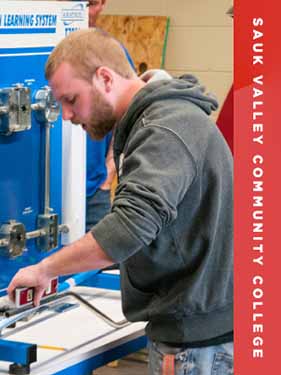The Pathways to Results process is built upon the implementation of an equity-focused continuous improvement model to serve all stakeholders within a student pathway. Since PTR’s inception, colleges have been forming councils, consisting of secondary and postsecondary educators, industry members, economic development professionals, and others believed to be vital to identifying barriers and overcoming them. This “full-court press” on a program has created rich dialogue that has unraveled many barriers to success and a pathway to improvement at Sauk Valley Community College (SVCC).
Staying true to its philosophy, OCCRL has implemented a second-year PTR process to support promising ideas for improvement. The idea is quite simple: pick up where first-year teams left off and continue unpacking the data while also implementing an evidence-based intervention for success.
Two years ago, SVCC embarked on the journey of PTR within its Multicraft Technology A.A.S. pathway. The program, which is manufacturing-based, allows a student to take a core set of required courses, but then specialize in a selected area, including Welding, HVAC, Alternative Energy, Electronics, or Electrical. This “jack-of-all trades” A.A.S. degree has provided manufacturers with some relief to the skills gap they’d been experiencing.
In terms of the pathway structures itself, Multicraft is a model program—it includes several stackable credentials on the way to a highly marketable A.A.S., as well as an articulated transfer agreement for students who would like to complete a four-year degree in Engineering Technology at either NIU or SIU. However, in terms of student success as measured both by what students learn (e.g. problem solving and critical thinking) and disaggregated completion rates, there is still work to be done and the PTR process has created the framework to advance these efforts.
One of the barriers identified in the team’s first-year process involved math requirements. In dissecting the data, it was concluded that students were putting off general education requirements and taking their technical classes in the first 2-3 semesters, which is a common, yet discouraged practice. This seemed to be acting as a roadblock to program completion. To better understand this issue, the team brought students to the table to create a mixed methods approach to analyzing this problem. As a result, the team found that integrating math across the curriculum might better prepare students and boost their confidence with the subject.
As the second year team begins to implement the integrated math curriculum, they have decided to go a step further and tackle a barrier that extends across our nation and far beyond just our rural community college in northern Illinois: developmental education. Faculty realized in conversation that despite the best efforts of many students, the diversity in this program really seemed to drop after the earliest courses because of math or reading skills gaps that leave many diverse students struggling and discouraged in the programmatic coursework. Developmental education, it seems, is a distinct barrier to equity in this pathway, and likely others. In a way, developmental education is also a continuous improvement process in itself. Given the potential to impact student outcomes, this team believes it is a fitting and worthy focus that will not only influence Multicraft or SVCC, but stakeholders well beyond this community.
Dr. Jon Mandrell serves as the Vice President of Academics and Student Services at Sauk Valley Community College in Dixon, Illinois, where he is the Chief Academic Officer (CAO) and Chief Student Services Officer (CSSO). He has worked closely with several manufacturing and workforce initiatives within the Sauk Valley community, local school districts, and its industry base. Over the years, much of these efforts have been made possible through the PTR processes.
